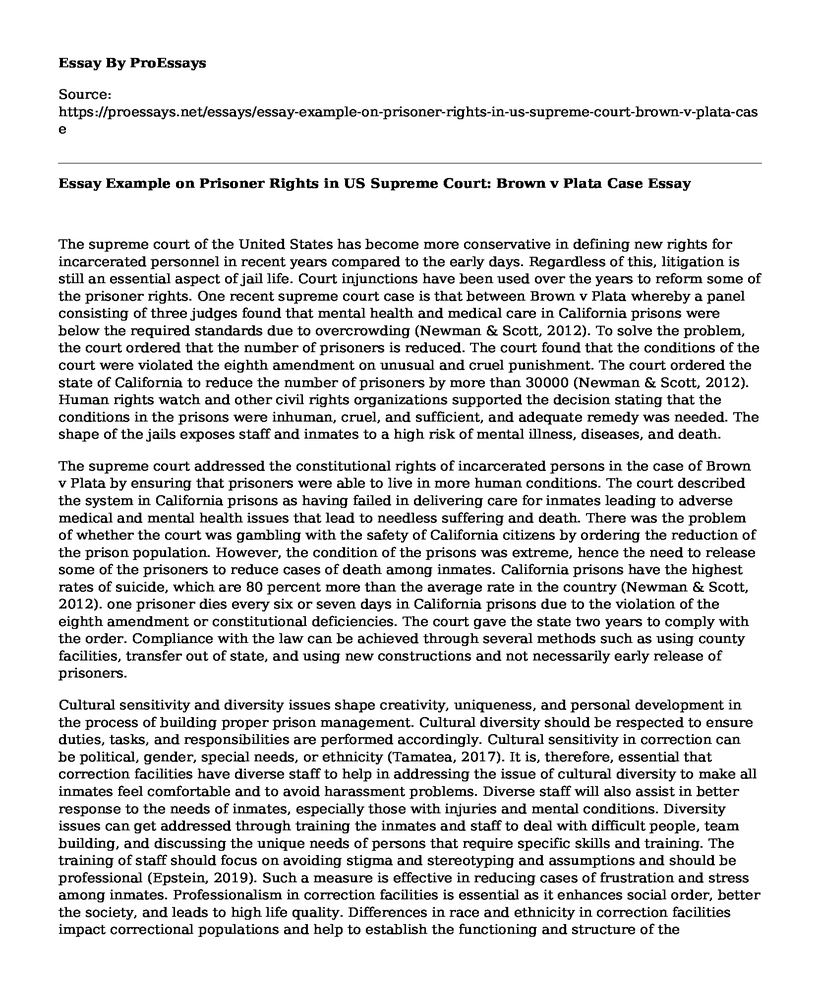The supreme court of the United States has become more conservative in defining new rights for incarcerated personnel in recent years compared to the early days. Regardless of this, litigation is still an essential aspect of jail life. Court injunctions have been used over the years to reform some of the prisoner rights. One recent supreme court case is that between Brown v Plata whereby a panel consisting of three judges found that mental health and medical care in California prisons were below the required standards due to overcrowding (Newman & Scott, 2012). To solve the problem, the court ordered that the number of prisoners is reduced. The court found that the conditions of the court were violated the eighth amendment on unusual and cruel punishment. The court ordered the state of California to reduce the number of prisoners by more than 30000 (Newman & Scott, 2012). Human rights watch and other civil rights organizations supported the decision stating that the conditions in the prisons were inhuman, cruel, and sufficient, and adequate remedy was needed. The shape of the jails exposes staff and inmates to a high risk of mental illness, diseases, and death.
The supreme court addressed the constitutional rights of incarcerated persons in the case of Brown v Plata by ensuring that prisoners were able to live in more human conditions. The court described the system in California prisons as having failed in delivering care for inmates leading to adverse medical and mental health issues that lead to needless suffering and death. There was the problem of whether the court was gambling with the safety of California citizens by ordering the reduction of the prison population. However, the condition of the prisons was extreme, hence the need to release some of the prisoners to reduce cases of death among inmates. California prisons have the highest rates of suicide, which are 80 percent more than the average rate in the country (Newman & Scott, 2012). one prisoner dies every six or seven days in California prisons due to the violation of the eighth amendment or constitutional deficiencies. The court gave the state two years to comply with the order. Compliance with the law can be achieved through several methods such as using county facilities, transfer out of state, and using new constructions and not necessarily early release of prisoners.
Cultural sensitivity and diversity issues shape creativity, uniqueness, and personal development in the process of building proper prison management. Cultural diversity should be respected to ensure duties, tasks, and responsibilities are performed accordingly. Cultural sensitivity in correction can be political, gender, special needs, or ethnicity (Tamatea, 2017). It is, therefore, essential that correction facilities have diverse staff to help in addressing the issue of cultural diversity to make all inmates feel comfortable and to avoid harassment problems. Diverse staff will also assist in better response to the needs of inmates, especially those with injuries and mental conditions. Diversity issues can get addressed through training the inmates and staff to deal with difficult people, team building, and discussing the unique needs of persons that require specific skills and training. The training of staff should focus on avoiding stigma and stereotyping and assumptions and should be professional (Epstein, 2019). Such a measure is effective in reducing cases of frustration and stress among inmates. Professionalism in correction facilities is essential as it enhances social order, better the society, and leads to high life quality. Differences in race and ethnicity in correction facilities impact correctional populations and help to establish the functioning and structure of the correctional program of the institution.
Conclusion
In conclusion, the rights of prisoners are protected in the constitution, and they should be respected. The Brown v Plata case is an example of a supreme court that addresses the rights of inmates that are violated. Prisoners have the right to live in human conditions to reduce the risk of diseases, mental illness, and deaths. Cultural sensitivity and diversity issues in correctional facilities should get addressed to ensure that social order is maintained and to avoid cases of stress and frustration. Diverse staff should be employed and trained to handle the various groups of people in the correction institution.
References
Epstein, W. M. (2019). Community Psychological Practice and a Note on Rehabilitation in Corrections. In Psychotherapy and the Social Clinic in the United States (pp. 195-236). Palgrave Macmillan, Cham.
Newman, W. J., & Scott, C. L. (2012). Brown v. Plata: prison overcrowding in California. Journal of the American Academy of Psychiatry and the Law Online, 40(4), 547-552. Retrieved from https://pdfs.semanticscholar.org/70f2/37d83ef3f90a11a1bd4e88df9d049d0f9f77.pdf
Tamatea, A. J. (2017). Culture is our business: Issues and challenges for forensic and correctional psychologists. Australian Journal of Forensic Sciences, 49(5), 564-578.
Cite this page
Essay Example on Prisoner Rights in US Supreme Court: Brown v Plata Case. (2023, Apr 24). Retrieved from https://proessays.net/essays/essay-example-on-prisoner-rights-in-us-supreme-court-brown-v-plata-case
If you are the original author of this essay and no longer wish to have it published on the ProEssays website, please click below to request its removal:
- History of Christianity in Hui Research
- The Media Influences on the Criminal Justice System Essay
- Political, Socioeconomic, and Cultural Development in China Between 770 B.C AND 907 A.D
- Essay Example on Post-Racial America? Uncovering Racism's Lingering Effects
- Research Paper on Racial Disproportionality in Criminal Justice System: Causes and Impacts
- Biography Sample on Jane Addams: Champion of Peace, Philanthropy, Work Ethic
- The Founding Documents: The Interplay of the Declaration of Independence and the United States Constitution







